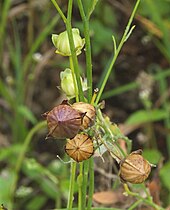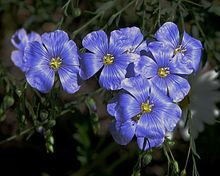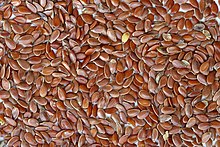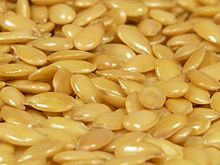| Flax | |
|---|---|
 | |
| Flax plant | |
| Scientific classification | |
| Kingdom: | Plantae |
| (unranked): | Angiosperms |
| (unranked): | Eudicots |
| (unranked): | Rosids |
| Order: | Malpighiales |
| Family: | Linaceae |
| Genus: | Linum |
| Species: | L. usitatissimum |
| Binomial name | |
| Linum usitatissimum Linnaeus. | |
Flax (also known as common flax or linseed) (binomial name: Linum usitatissimum) is a member of the genus Linum in the family Linaceae. It is native to the region extending from the eastern Mediterranean to India and was probably first domesticated in the Fertile Crescent. Flax was extensively cultivated in ancient Ethiopia and ancient Egypt.[1] A discovery reported in 2009 of spun, dyed, and knotted wild flax fibers in a prehistoric cave in the Republic of Georgia shows that the plant was already in use by humans at the surprisingly early date of 30,000 B.C.[2][3] New Zealand flax is not related to flax but was named after it, as both plants are used to produce fibers.
Contents[hide] |
[edit]Description
Flax is an erect annual plant growing to 1.2 m (3 ft 11 in) tall, with slender stems. The leaves are glaucous green, slender lanceolate, 20–40 mm long and 3 mm broad. Theflowers are pure pale blue, 15–25 mm diameter, with five petals; they can also be bright red. The fruit is a round, dry capsule 5–9 mm diameter, containing several glossy brown seeds shaped like an apple pip, 4–7 mm long.
In addition to referring to the plant itself, the word "flax" may refer to the unspun fibers of the flax plant.
[edit]History
Flax fibers are amongst the oldest fiber crops in the world. The use of flax for the production of linen goes back at least to ancient Egyptian times. Dyed flax fibers found in a cave in Dzudzuana (prehistoric Georgia) have been dated to 30,000 years ago.[4] Pictures on tombs and temple walls at Thebes depict flowering flax plants. The use of flax fiber in the manufacturing of cloth in northern Europe dates back toNeolithic times. In North America, flax was introduced by the Puritans.[citation needed]
[edit]Uses
Flax is grown for its use as an edible oil, as a nutritional supplement, and as an ingredient in many wood finishing products. Flax is also grown as an ornamental plant in gardens. Flax fibers are used to make linen. The Latin species name usitatissimum means most useful, pointing to the several traditional uses of the plant and their importance for human life.
[edit]Flax seeds
Flax seeds come in two basic varieties: (1) brown; and (2) yellow or golden. Most types have similar nutritional characteristics and equal numbers of short-chain omega-3 fatty acids. The exception is a type of yellow flax called solin (trade name Linola), which has a completely different oil profile and is very low in omega-3 FAs. Although brown flax can be consumed as readily as yellow, and has been for thousands of years, it is better known as an ingredient in paints, fiber and cattle feed. Flax seeds produce a vegetable oil known as flaxseed or linseed oil, which is one of the oldest commercial oils, and solvent-processed flax seed oil has been used for centuries as a drying oil in painting and varnishing.[citation needed]
One hundred grams of ground flax seed supplies about 450 calories, 41 grams of fat, 28 grams of fiber, and 20 grams of protein.[5]
Flax seed sprouts are edible, with a slightly spicy flavor. Excessive consumption of flax seeds with inadequate water can cause bowel obstruction.[6] Flaxseed, called ('Tisi' or 'Alsi') in northern India, has been roasted, powdered and eaten with boiled rice, a little water, and a little salt since ancient times in the villages.[citation needed]
Whole flax seeds are chemically stable, but ground flaxseed can go rancid at room temperature in as little as one week.[7] Refrigeration and storage in sealed containers will keep ground flax from becoming rancid for a longer period; under conditions similar to those found in commercial bakeries, trained sensory panelists could not detect differences between bread made with freshly ground flax and bread made with milled flax stored for four months at room temperature.[8] Milled flax is remarkably stable to oxidation when stored for nine months at room temperature if packed immediately without exposure to air and light[9] and for 20 months at ambient temperatures under warehouse conditions.[8]
Three natural phenolic glucosides, secoisolariciresinol diglucoside, p-coumaric acid glucoside and ferulic acid glucoside, can be found in commercial breads containing flaxseed.[10]
[edit]Nutrients and clinical research
Main article: Linseed oil
| Nutritional value per 100 g (3.5 oz) | |
|---|---|
| Energy | 2,234 kJ (534 kcal) |
| Carbohydrates | 28.88 g |
| - Sugars | 1.55 g |
| - Dietary fiber | 27.3 g |
| Fat | 42.16 g |
| - saturated | 3.663 |
| - monounsaturated | 7.527 |
| - polyunsaturated | 28.730 |
| Protein | 18.29 g |
| Thiamine (vit. B1) | 1.644 mg (143%) |
| Riboflavin (vit. B2) | 0.161 mg (13%) |
| Niacin (vit. B3) | 3.08 mg (21%) |
| Pantothenic acid (B5) | 0.985 mg (20%) |
| Vitamin B6 | 0.473 mg (36%) |
| Folate (vit. B9) | 0 μg (0%) |
| Vitamin C | 0.6 mg (1%) |
| Calcium | 255 mg (26%) |
| Iron | 5.73 mg (44%) |
| Magnesium | 392 mg (110%) |
| Phosphorus | 642 mg (92%) |
| Potassium | 813 mg (17%) |
| Zinc | 4.34 mg (46%) |
| Percentages are relative to US recommendations for adults. Source: USDA Nutrient Database | |
Flax seeds contain high levels of dietary fiber as well as lignans, an abundance ofmicronutrients and omega-3 fatty acids (table). Studies have shown that flax seeds may lower cholesterol levels, although with differing results in terms of gender. One study found results were better for women [11] whereas a later study found benefits only for men.[12]Initial studies suggest that flax seeds taken in the diet may benefit individuals with certain types of breast[13][14] and prostate cancers.[15] A study done at Duke University suggests that flaxseed may stunt the growth of prostate tumors,[15] although a meta-analysis found the evidence on this point to be inconclusive.[16] Flax may also lessen the severity of diabetes by stabilizing blood-sugar levels.[17] There is some support for the use of flax seed as a laxative due to its dietary fiber content[6] though excessive consumption without liquid can result in intestinal blockage.[18] Consuming large amounts of flax seed may impair the effectiveness of certain oral medications, due to its fiber content,[18] and may have adverse effects due to its content of neurotoxic cyanogen glycosides and immunosuppressive cyclic nonapeptides.[19]
One of the main components of flax is lignan, which has plant estrogen as well asantioxidants (flax contains up to 800 times more lignans than other plant foods contain).[20]




No comments:
Post a Comment